Role of Hydroxy Group in the Electro-Optical Properties of Polymer-Dispersed Liquid Crystals
Abstract
:1. Introduction
2. Experimental
2.1. Materials
2.2. Sample Preparation
2.3. Characterization
3. Results and Discussion
3.1. Effects of Monofunctional Monomers with Hydroxy Group
3.2. Effects of Liquid Crystalline Molecules with Hydroxy Group
3.3. Demonstration of the Samples
4. Conclusions
Author Contributions
Funding
Data Availability Statement
Conflicts of Interest
References
- Shrestha, M.; Lau, G.K.; Bastola, A.K.; Lu, Z.; Asundi, A.; Teo, E.H.T. Emerging tunable window technologies for active transparency tuning. Appl. Phys. Rev. 2022, 9, 31304. [Google Scholar] [CrossRef]
- Zhou, L.; Liu, S. Development and Prospect of Viewing Angle Switchable Liquid Crystal Devices. Crystals 2022, 12, 1347. [Google Scholar] [CrossRef]
- Sharma, V.; Kumar, P.; Raina, K.K. Simultaneous effects of external stimuli on preparation and performance parameters of normally transparent reverse mode polymer-dispersed liquid crystals—A review. J. Mater. Sci. 2021, 56, 18795–18836. [Google Scholar] [CrossRef]
- Saeed, M.H.; Zhang, S.; Cao, Y.; Zhou, L.; Hu, J.; Muhammad, I.; Xiao, J.; Zhang, L.; Yang, H. Recent Advances in The Polymer Dispersed Liquid Crystal Composite and Its Applications. Molecules 2020, 25, 5510. [Google Scholar] [CrossRef]
- Zhang, H.; Miao, Z.; Shen, W. Development of polymer-dispersed liquid crystals: From mode innovation to applications. Compos. Part A Appl. Sci. Manuf. 2022, 163, 107234. [Google Scholar] [CrossRef]
- Kamal, W.; Li, M.; Lin, J.; Parry, E.; Jin, Y.; Elston, S.J.; Castrejón-Pita, A.A.; Morris, S.M. Spatially Patterned Polymer Dispersed Liquid Crystals for Image—Integrated Smart Windows. Adv. Opt. Mater. 2021, 10. [Google Scholar] [CrossRef]
- Nicoletta, F.P.; Chidichimo, G.; Cupelli, D.; De Filpo, G.; De Benedittis, M.; Gabriele, B.; Salerno, G.; Fazio, A. Electrochromic Polymer-Dispersed Liquid-Crystal Film: A New Bifunctional Device. Adv. Funct. Mater. 2005, 15, 995–999. [Google Scholar] [CrossRef]
- Iluyemi, D.C.; Nundy, S.; Shaik, S.; Tahir, A.; Ghosh, A. Building energy analysis using EC and PDLC based smart switchable window in Oman. Sol. Energy 2022, 237, 301–312. [Google Scholar] [CrossRef]
- Oh, S.-W.; Baek, J.-M.; Heo, J.; Yoon, T.-H. Dye-doped cholesteric liquid crystal light shutter with a polymer-dispersed liquid crystal film. Dye. Pigment. 2016, 134, 36–40. [Google Scholar] [CrossRef]
- Jiang, J.; McGraw, G.; Ma, R.; Brown, J.; Yang, D.-K. Selective scattering polymer dispersed liquid crystal film for light enhancement of organic light emitting diode. Opt. Express 2017, 25, 3327–3335. [Google Scholar] [CrossRef]
- Lai, Y.-T.; Kuo, J.-C.; Yang, Y.-J. A novel gas sensor using polymer-dispersed liquid crystal doped with carbon nanotubes. Sens. Actuators A Phys. 2014, 215, 83–88. [Google Scholar] [CrossRef]
- Doane, J.W.; Golemme, A.; West, J.L.; Whitehead, J.B., Jr.; Wu, B.-G. Polymer Dispersed Liquid Crystals for Display Application. Mol. Cryst. Liq. Cryst. Inc. Nonlinear Opt. 1988, 165, 511–532. [Google Scholar] [CrossRef]
- Liang, X.; Guo, C.; Chen, M.; Guo, S.; Zhang, L.; Li, F.; Guo, S.; Yang, H. A roll-to-roll process for multi-responsive soft-matter composite films containing CsxWO3 nanorods for energy-efficient smart window applications. Nanoscale Horiz. 2017, 2, 319–325. [Google Scholar] [CrossRef] [PubMed]
- Liang, X.; Chen, M.; Chen, G.; Li, C.; Han, C.; Zhang, J.; Zhang, J.; Zhang, L.; Yang, H. Effects of polymer micro-structures on the thermo-optical properties of a flexible soft-mater film based on liquid crystals/polymer composite. Polymer 2018, 146, 161–168. [Google Scholar] [CrossRef]
- Chen, M.; Liang, X.; Hu, W.; Zhang, L.; Zhang, C.; Yang, H. A polymer microsphere-filled cholesteric-liquid crystal film with bistable electro-optical characteristics. Mater. Des. 2018, 157, 151–158. [Google Scholar] [CrossRef]
- Chang, S.J.; Lin, C.M.; Fuh, A.Y.G. Studies of polymer ball type polymer dispersed liquid crystal films. Liq. Cryst. 1996, 21, 19–23. [Google Scholar] [CrossRef]
- Hu, W.; Chen, M.; Zhou, L.; Zhong, T.; Yuan, X.; Chen, F.; Zhang, L. Nonelectric Sustaining Bistable Polymer Framework Liquid Crystal Films with a Novel Semirigid Polymer Matrix. ACS Appl. Mater. Interfaces 2018, 10, 22757–22766. [Google Scholar] [CrossRef]
- Guo, S.-M.; Liang, X.; Zhang, C.-H.; Chen, M.; Shen, C.; Zhang, L.-Y.; Yuan, X.; He, B.-F.; Yang, H. Preparation of a Thermally Light-Transmittance-Controllable Film from a Coexistent System of Polymer-Dispersed and Polymer-Stabilized Liquid Crystals. ACS Appl. Mater. Interfaces 2017, 9, 2942–2947. [Google Scholar] [CrossRef]
- Jamil, M.; Ahmad, F.; Rhee, J.T.; Jeon, Y.J. High dielectric properties, TiO2 nanoparticles doped PDLC devices for lower switching voltage. Liq Cryst. 2022, 49, 333–342. [Google Scholar]
- Jamil, M.; Ahmad, F.; Rhee, J.T.; Jeon, Y.J. Nanoparticle-doped polymer-dispersed liquid crystal display. Curr. Sci. 2011, 101, 1544–1552. [Google Scholar]
- Kim, E.-H.; Myoung, S.-W.; Lee, W.-R.; Jung, Y.-G. Electro-Optical Properties of Holographic PDLC Containing Polyhedral Oligomeric Silsesquioxane. J. Korean Phys. Soc. 2009, 54, 1180–1186. [Google Scholar] [CrossRef]
- Zheng, Z.; Ma, J.; Li, W.; Song, J.; Liu, Y.; Xuan, L. Improvements in morphological and electro-optical properties of polymer-dispersed liquid crystal grating using a highly fluorine—Substituted acrylate monomer. Liq. Cryst. 2008, 35, 885–893. [Google Scholar] [CrossRef]
- Wu, Y.-C.; Kuo, S.-W. Synthesis and characterization of polyhedral oligomeric silsesquioxane (POSS) with multifunctional benzoxazine groups through click chemistry. Polymer 2010, 51, 3948–3955. [Google Scholar] [CrossRef]
- Seok, J.-W.; Han, Y.S.; Kwon, Y.; Park, L.S. Structural effect of photoinitiators on electro-optical properties of polymer-dispersed liquid crystal composite films. J. Appl. Polym. Sci. 2005, 99, 162–169. [Google Scholar] [CrossRef]
- Lan, T.; Yang, W.; Peng, J.; Li, M.; Wang, Y. Effect of graft copolymer matrix prepared by reversible addition-fragmentation chain transfer and atom transfer radical polymerization on the electro-optical properties of polymer-dispersed liquid crystals. Polym. Int. 2014, 63, 1691–1698. [Google Scholar] [CrossRef]
- Lan, T.; Zhang, Y.; Wang, H.; Yang, L.; Yang, W.; Wang, Y. The improvement of electro-optical properties of polymer-dispersed liquid crystals with graft copolymer matrix synthesized by reversible addition-fragmentation chain transfer and atom transfer radical polymerization. Polym. Int. 2014, 64, 405–412. [Google Scholar] [CrossRef]
- Zhang, H.; Zhao, Y.; Yu, P.; He, Z.; Miao, Z.; Shen, W. Fabrication of epoxy/thiol polymer-based polymer-dispersed liquid crystals containing a catalyst with multi-amine structures. Opt. Mater. 2022, 133, 112883. [Google Scholar] [CrossRef]
- Zhang, L.; Liu, Y.; Shi, Z.; He, T.; Gong, X.; Geng, P.; Gao, Z.; Wang, Y. Effects of alkyl chain length of monomer and dye-doped type on the electro-optical properties of polymer-dispersed liquid crystal films prepared by nucleophile-initiated thiol-ene click reaction. Liq. Cryst. 2019, 47, 658–672. [Google Scholar] [CrossRef]
- Kizhakidathazhath, R.; Nishikawa, H.; Okumura, Y.; Higuchi, H.; Kikuchi, H. High-Performance Polymer Dispersed Liquid Crystal Enabled by Uniquely Designed Acrylate Monomer. Polymers 2020, 12, 1625. [Google Scholar] [CrossRef]
- Ahmad, F.; Jamil, M.; Jeon, Y.J.; Woo, L.J.; Jung, J.E.; Lee, G.H.; Park, J. Comparative study on the electrooptical properties of polymer-dispersed liquid crystal films with different mixtures of monomers and liquid crystals. J. Appl. Polym. Sci. 2011, 121, 1424–1430. [Google Scholar] [CrossRef]
- Zhang, H.; Cao, H.; Chen, M.; Zhang, L.; Jiang, T.; Chen, H.; Li, F.; Zhu, S.; Yang, H. Effects of the fluorinated liquid crystal molecules on the electro-optical properties of polymer dispersed liquid crystal films. Liq. Cryst. 2017, 44, 2301–2310. [Google Scholar] [CrossRef]
- Lin, H.; Zhang, S.; Saeed, M.H.; Zhou, L.; Gao, H.; Huang, J.; Zhang, L.; Yang, H.; Xiao, J.; Gao, Y. Effects of the methacrylate monomers with different end groups on the morphologies, electro-optical and mechanical properties of polymer dispersed liquid crystals composite films. Liq. Cryst. 2020, 48, 722–734. [Google Scholar] [CrossRef]
- Hu, J.; Hu, W.; Zhang, S.; Sun, C.; Lan, R.; Cao, Y.; Ren, Y.; Xu, J.; Wang, X.; Saeed, M.H.; et al. Combined effect of hydroxylated and fluorinated acrylate monomers on improving the electro-optical and mechanical performances of PDLC-films. Liq. Cryst. 2021, 49, 769–779. [Google Scholar] [CrossRef]
- Wang, L.; Yang, H.; Zhao, C.; Zhang, L.; Yang, H. Effects of 2-Hydroxypropyl Acrylate on Electro-Optical Properties of Polymer-Dispersed Liquid Crystal Films and Elasticity of Polymer Network. Mol. Cryst. Liq. Cryst. 2010, 518, 3–11. [Google Scholar] [CrossRef]
- Zhang, C.; Wang, D.; Cao, H.; Song, P.; Yang, C.; Yang, H.; Hu, G.-H. Preparation and electro-optical properties of polymer dispersed liquid crystal films with relatively low liquid crystal content. Polym. Adv. Technol. 2013, 24, 453–459. [Google Scholar] [CrossRef]
- Li, W.; Yu, L.; He, W.; Yuan, X.; Zhao, D.; Huang, W.; Cao, H.; Yang, Z.; Yang, H. Effect of a Photopolymerizable Monomer Containing a Hydrogen Bond on Near-Infrared Radiation Transmittance of Nematic Liquid Crystal/Monomers Composites. J. Phys. Chem. C 2008, 112, 13739–13743. [Google Scholar] [CrossRef]
- Zhang, S.; Zhong, T.; Wang, Q.; Li, C.; Wang, X.; Zhang, L.; Cao, H.; Yang, Z.; Yang, H. Synthesis, characterisation and comparative study of the hydroxyl, acrylate and vinyl-ether terminated cyanobiphenyl bridged with different spacer lengths. Liq. Cryst. 2020, 48, 168–181. [Google Scholar] [CrossRef]
- Li, W.; Cao, H.; Kashima, M.; Liu, F.; Cheng, Z.; Yang, Z.; Zhu, S.; Yang, H. Control of the microstructure of polymer network and effects of the microstructures on light scattering properties of UV-cured polymer-dispersed liquid crystal films. J. Polym. Sci. Part B Polym. Phys. 2008, 46, 2090–2099. [Google Scholar] [CrossRef]

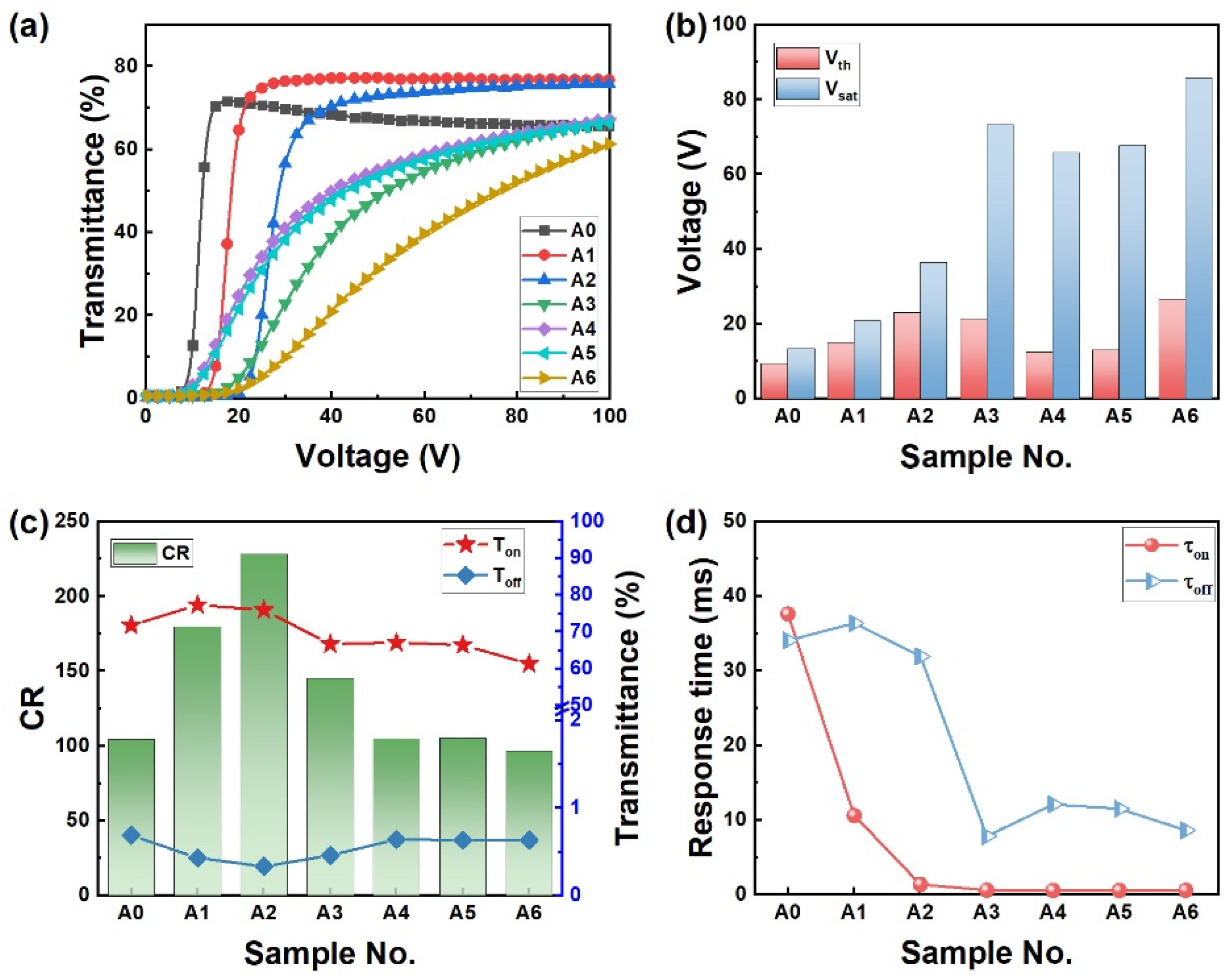

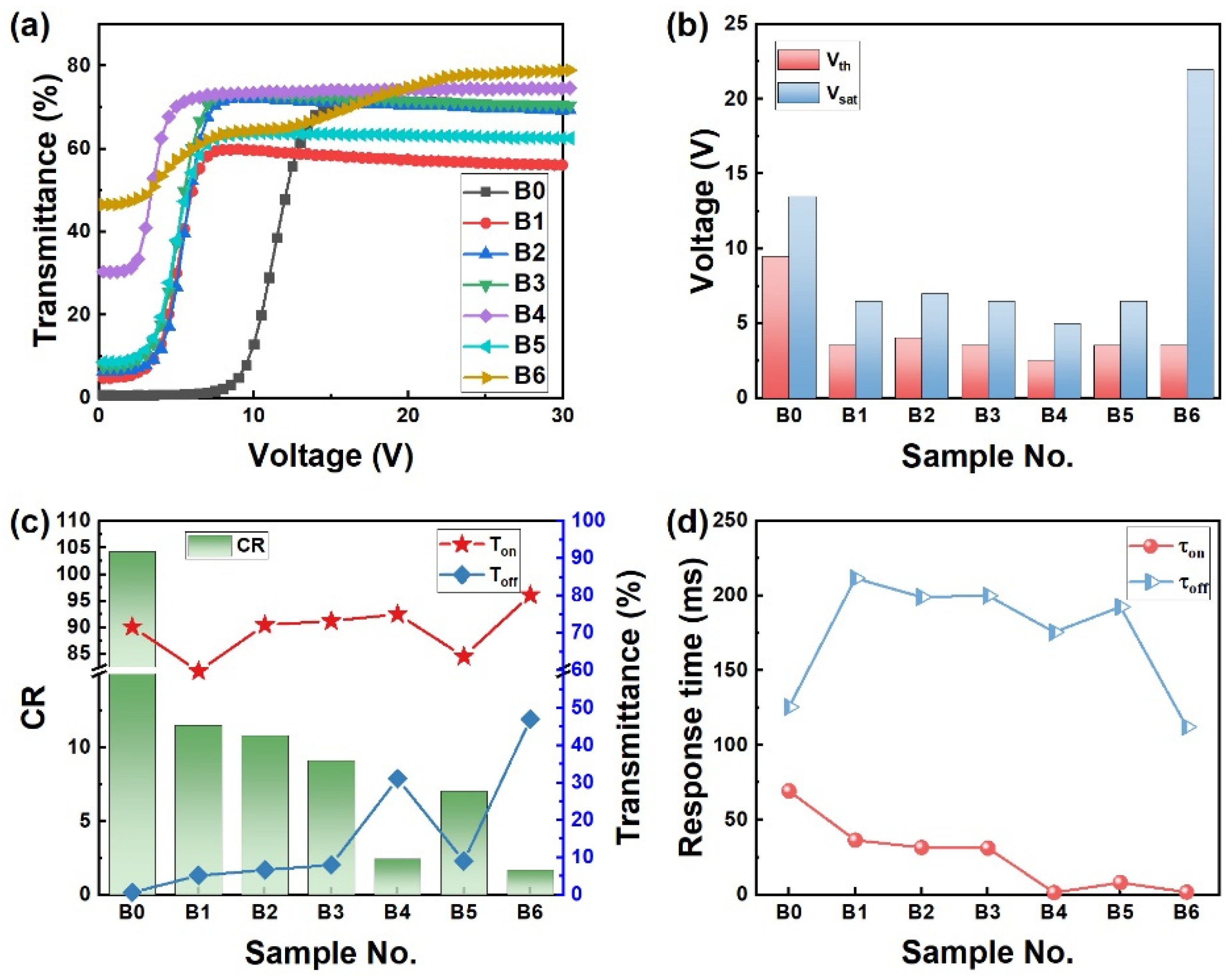

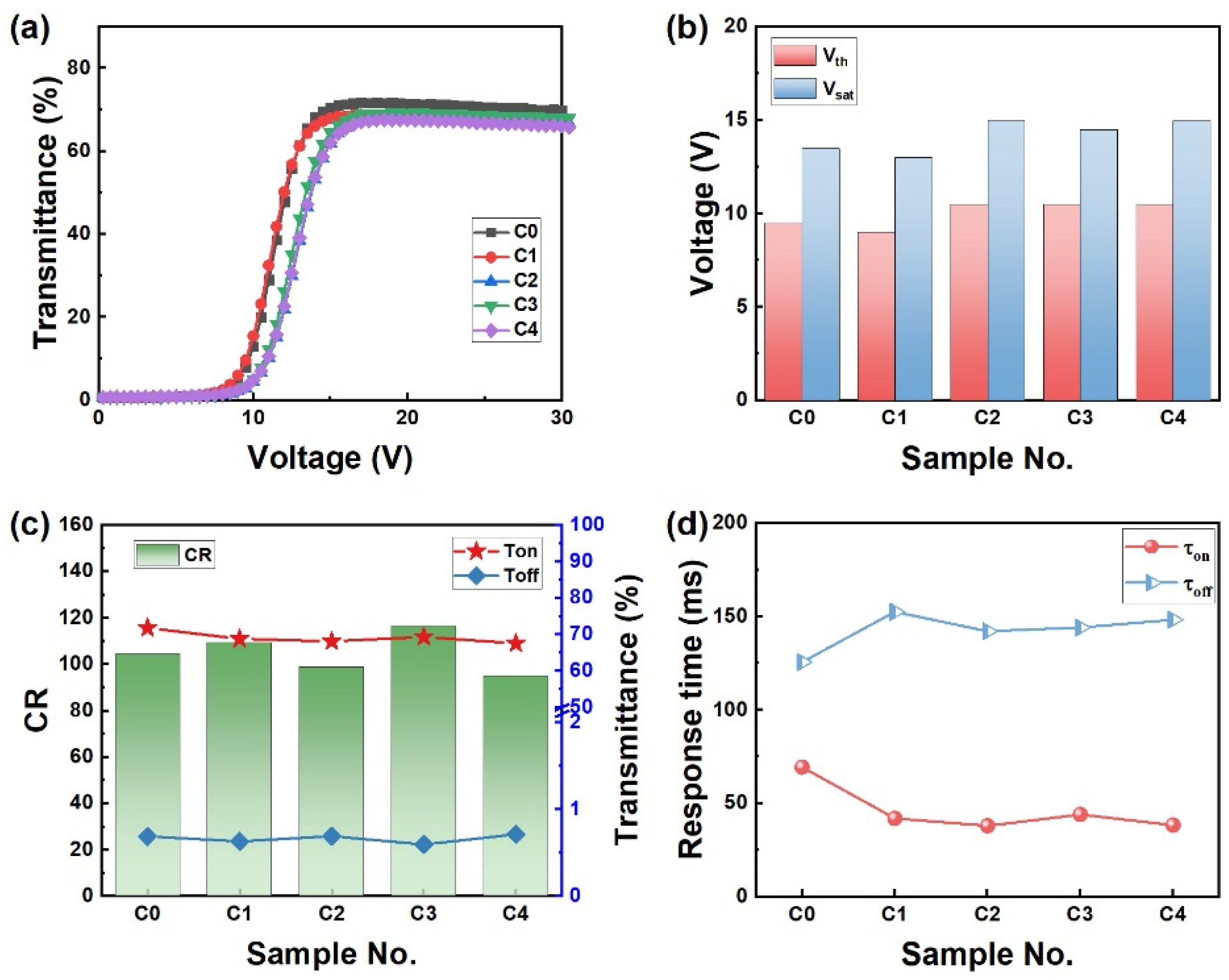

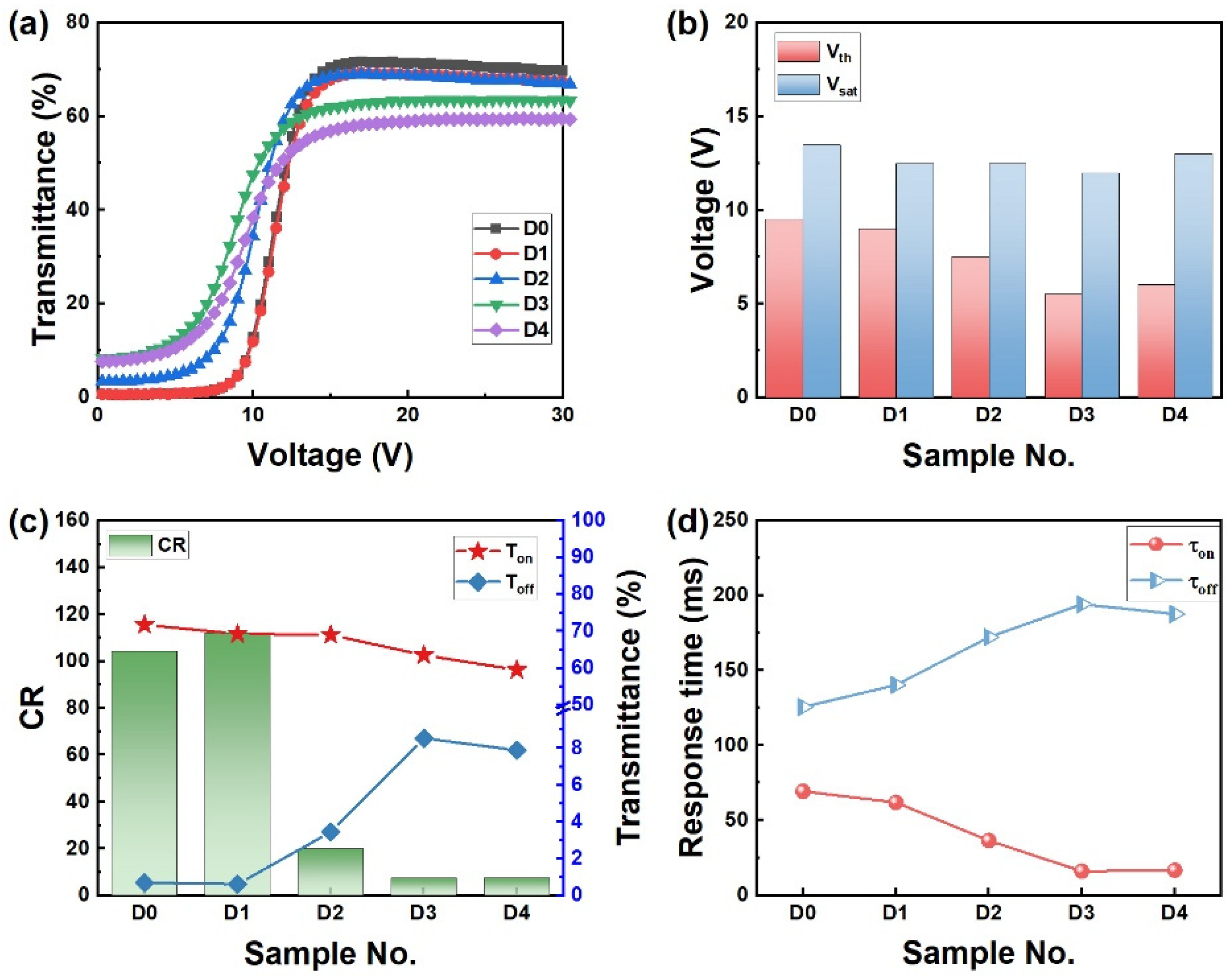

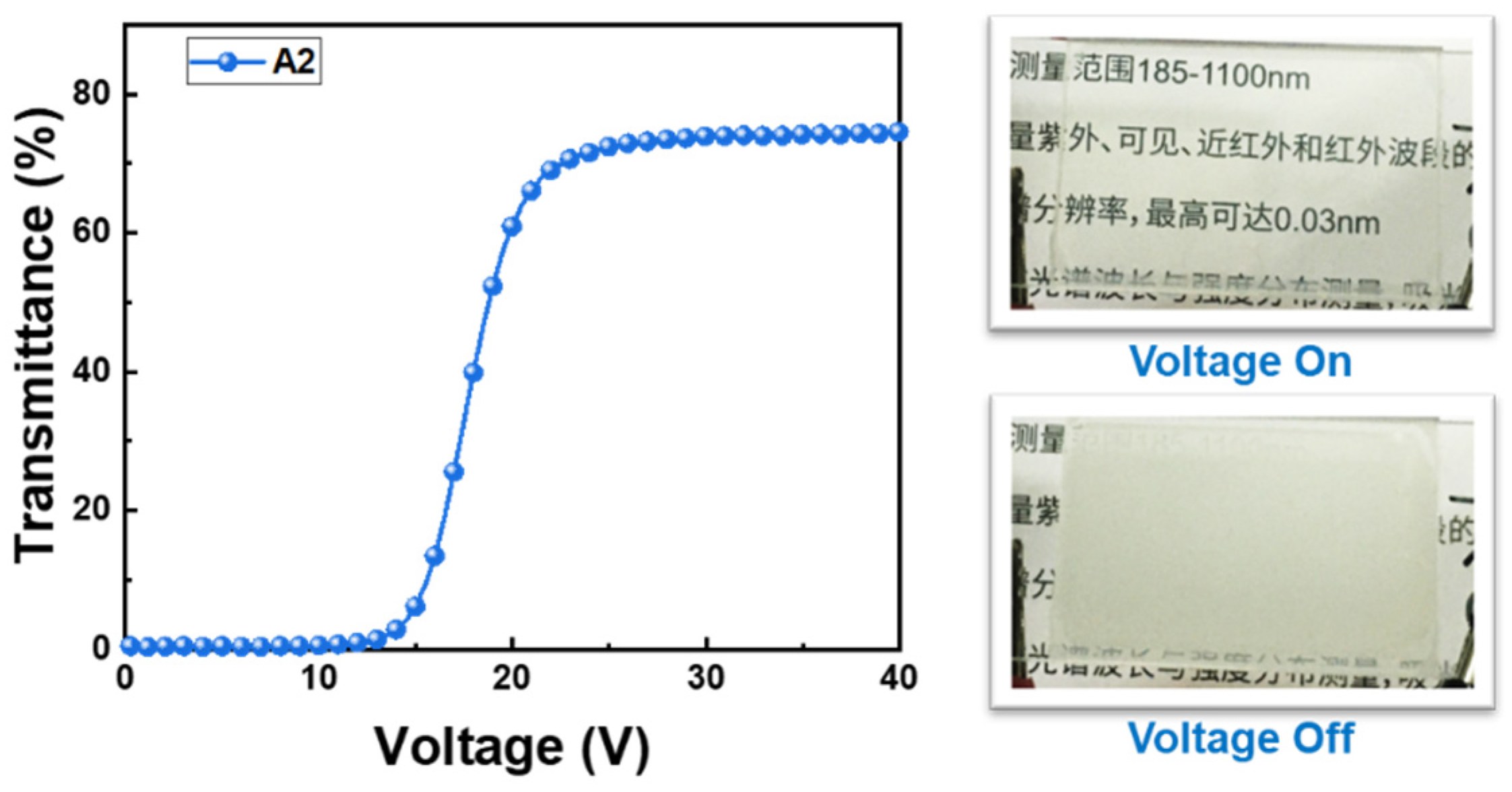
| Sample No. | Composition | |||||
|---|---|---|---|---|---|---|
| CHMA | HPMA | BDDA | PEGDA600 | E8 | Irg651 | |
| A0 | 32.0 | 0 | 1.6 | 6.4 | 60.0 | 2.0 |
| A1 | 24.0 | 8.0 | 1.6 | 6.4 | 60.0 | 2.0 |
| A2 | 21.3 | 10.7 | 1.6 | 6.4 | 60.0 | 2.0 |
| A3 | 16.0 | 16.0 | 1.6 | 6.4 | 60.0 | 2.0 |
| A4 | 10.7 | 21.3 | 1.6 | 6.4 | 60.0 | 2.0 |
| A5 | 8.0 | 24.0 | 1.6 | 6.4 | 60.0 | 2.0 |
| A6 | 0 | 32.0 | 1.6 | 6.4 | 60.0 | 2.0 |
| Sample No. | Composition | |||||
|---|---|---|---|---|---|---|
| CHMA | IBMA | BDDA | PEGDA600 | E8 | Irg651 | |
| B0 (A0) | 32.0 | 0 | 1.6 | 6.4 | 60.0 | 2.0 |
| B1 | 24.0 | 8.0 | 1.6 | 6.4 | 60.0 | 2.0 |
| B2 | 21.3 | 10.7 | 1.6 | 6.4 | 60.0 | 2.0 |
| B3 | 16.0 | 16.0 | 1.6 | 6.4 | 60.0 | 2.0 |
| B4 | 10.7 | 21.3 | 1.6 | 6.4 | 60.0 | 2.0 |
| B5 | 8.0 | 24.0 | 1.6 | 6.4 | 60.0 | 2.0 |
| B6 | 0 | 32.0 | 1.6 | 6.4 | 60.0 | 2.0 |
| Sample No. | Composition | |||||
|---|---|---|---|---|---|---|
| CHMA | BDDA | PEGDA600 | E8 | 8OHCB | Irg651 | |
| C0 | 32.0 | 1.6 | 6.4 | 60.0 | 0 | 2.0 |
| C1 | 32.0 | 1.6 | 6.4 | 57.0 | 3.0 | 2.0 |
| C2 | 32.0 | 1.6 | 6.4 | 54.0 | 6.0 | 2.0 |
| C3 | 32.0 | 1.6 | 6.4 | 51.0 | 9.0 | 2.0 |
| C4 | 32.0 | 1.6 | 6.4 | 48.0 | 12.0 | 2.0 |
| Sample No. | Composition | |||||
|---|---|---|---|---|---|---|
| CHMA | BDDA | PEGDA600 | E8 | 8OCB | Irg651 | |
| D0 | 32.0 | 1.6 | 6.4 | 60.0 | 0 | 2.0 |
| D1 | 32.0 | 1.6 | 6.4 | 57.0 | 3.0 | 2.0 |
| D2 | 32.0 | 1.6 | 6.4 | 54.0 | 6.0 | 2.0 |
| D3 | 32.0 | 1.6 | 6.4 | 51.0 | 9.0 | 2.0 |
| D4 | 32.0 | 1.6 | 6.4 | 48.0 | 12.0 | 2.0 |
Disclaimer/Publisher’s Note: The statements, opinions and data contained in all publications are solely those of the individual author(s) and contributor(s) and not of MDPI and/or the editor(s). MDPI and/or the editor(s) disclaim responsibility for any injury to people or property resulting from any ideas, methods, instructions or products referred to in the content. |
© 2023 by the authors. Licensee MDPI, Basel, Switzerland. This article is an open access article distributed under the terms and conditions of the Creative Commons Attribution (CC BY) license (https://creativecommons.org/licenses/by/4.0/).
Share and Cite
Yu, M.; Xu, J.; Luo, L.; Zhang, L.; Gao, Y.; Zou, C.; Wang, Q.; Wei, H.; Wang, X.; Yang, H. Role of Hydroxy Group in the Electro-Optical Properties of Polymer-Dispersed Liquid Crystals. Crystals 2023, 13, 843. https://doi.org/10.3390/cryst13050843
Yu M, Xu J, Luo L, Zhang L, Gao Y, Zou C, Wang Q, Wei H, Wang X, Yang H. Role of Hydroxy Group in the Electro-Optical Properties of Polymer-Dispersed Liquid Crystals. Crystals. 2023; 13(5):843. https://doi.org/10.3390/cryst13050843
Chicago/Turabian StyleYu, Meina, Jianjun Xu, Lingpeng Luo, Luoning Zhang, Yanzi Gao, Cheng Zou, Qian Wang, Huiyun Wei, Xiao Wang, and Huai Yang. 2023. "Role of Hydroxy Group in the Electro-Optical Properties of Polymer-Dispersed Liquid Crystals" Crystals 13, no. 5: 843. https://doi.org/10.3390/cryst13050843





